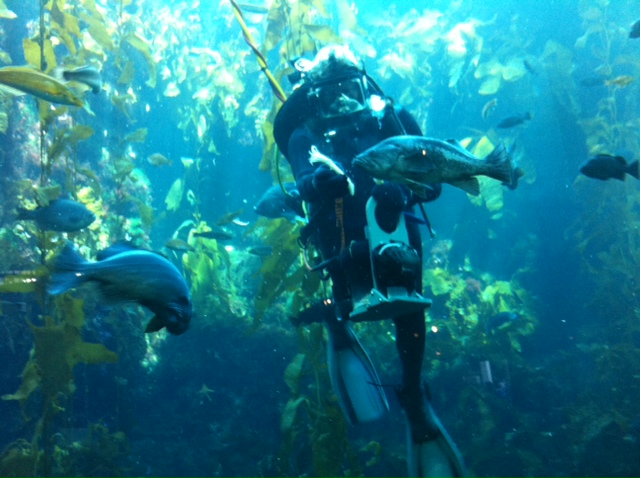
Anne Scanlon’s classroom is cold, wet and smells like fish and seaweed. She wouldn't have it any other way. That’s because Scanlon is not only an informal educator, but one of 100 specially trained volunteer scuba divers at Monterey Bay Aquarium in California.
With the help of a microphone in her mask, Scanlon answers questions—between breaths—from the live audiences right in front of her while she is hand-feeding ocean animals in the Aquarium’s 28-foot-high living Kelp Forest.
Thanks to a special kelp forest web cam, her online "classroom" extends even farther beyond the exhibit's glass walls, including to schools around the country, where classes tune in during live feeding presentations at 11:30 am and 4 pm Pacific time. (The kelp web cam is live online from 7 am to 7 pm, 364 days a year.) Both volunteer and staff divers at the Aquarium are part of a powerful platform to educate the public, says George Peterson, MBA Dive Program Manager. "By sharing the excitement of the underwater world, while they are right in it, our divers help connect what folks are seeing with how it affects them in their everyday life. People get the message that whether they live near or far from away from the ocean, they can be part of its conservation." An elementary school library media specialist in Pacific Grove, California, Scanlon dives against the backdrop of swaying plants that can grow an average four inches a day. She introduces children and adults to the marine forest habitat and its many species, including wolf eels, leopard sharks, sardines, sea stars, rockfish, sheephead fish, sea urchins, and abalone. (Sea otters also live in wild kelp forests, but at the Aquarium they have their own exhibit and web cam.)
As Scanlon interacts with the animals to deliver food—sort of a "Meals on Eels" system—she describes how marine animals and plants adapt to life in cold coastal waters, how they interact in the kelp forest ecosystem, how the forest changes during the seasons, and what happens in the wild kelp forest just hundreds of yards away in Monterey Bay. Scanlon's presentations illustrate a major principle of the Ocean Literacy Framework, that “The Ocean supports a great diversity of life and ecosystems.” Howtosmile.org's Ocean Literacy topic section connects all seven ocean literacy principles to specific SMILE activities including those with a kelp forest theme: Kelp Critters, Sensational Seaweed, Otter Smorgasbord, and the Monterey Bay Aquarium activity Is There Kelp in Your Cupboard, where learners play an online game and look through their cupboards at home to explore which food or other products like toothpaste, frozen desserts, and salad dressings contain kelp.
